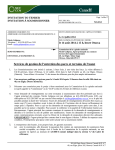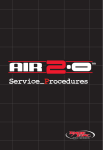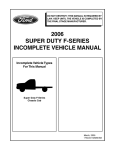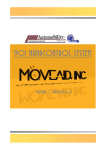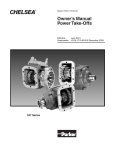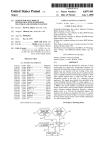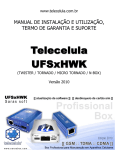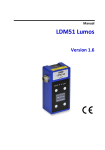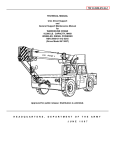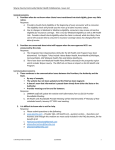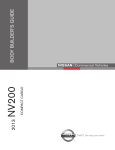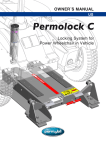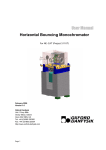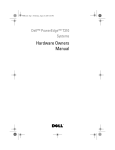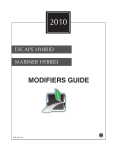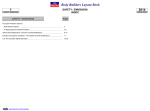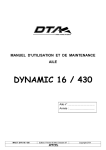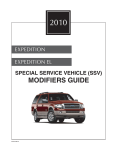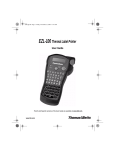Download Common Guidebook
Transcript
May, 2004 To: All Participants in Ford Truck Quality Programs (FTQP) Subject: Updated program guidelines Background: Ford Motor Company's vehicle modifier programs started in the mid-1980s with the ambulance Qualified Vehicle Modifier (QVM) program and the rest of the Ford Truck Quality Programs (FTQP) derived from that strong start. Although the industries represented by the individual programs are different, the quality programs' content and assessment process are very similar. In order to introduce consistency to the different programs and to take advantage of potential internal efficiencies by publishing a common guidebook, the following sections contain the new Ford Quality Program Guidebook. What's New: With the efficiencies inherent in publishing on the internet, Ford will no longer be shipping binders and printed materials. All updates will be on the web at this website: www.fleet.ford.com/truckbbas. Select 'Publications' on the pull down menu. If a builder wishes a new binder, contact the appropriate program engineer listed in Appendix XIII. We will send them out as long as they last, but new ones will not be printed. Each complete guidebook will contain the same common section and all the same appendices. Each unique industry need only download the unique section that applies to that industry. The engineering assessment rating form will combine the results of the common section and the unique section and is found at the end of the unique section of each guide. The layout of each section of the guide is similar to what you have seen in the individual guidebooks in the past. In the spirit of continuous improvement, there have been several changes to the individual and common program contents. For changes to the individual programs, see that section of the guidebook. In the common section of the guidebook, a few of criteria have been "upgraded" in importance – usually from a "2-pointer" to a "MR" – Minimum Requirement. Also, several new criteria have been incorporated based on industry experience. Page 2 of this letter describes the upgraded sections of the guidebook since its publication in the spring of 2002. It is anticipated that modifiers who are currently meeting their individual program requirements will have little problem complying with the revised requirements. However, it is strongly suggested that your engineering, compliance, quality, service, and production personnel carefully review the guidebook for compliance with the requirements and recommendations of both the common and unique sections. What's Expected: Each builder should initiate and implement programs to assure compliance with the guidelines. When it is time for your company to receive an engineering assessment, you will be contacted by the administrator of your program. You may be requested to submit specific data demonstrating compliance with program requirements ahead of the visit. Note that the assessment will cover the whole guidebook, not just the revised sections. Feel free to contact your administrator to schedule an engineering assessment or to get clarification on any issues. Sincerely: Dan Snyder – Supervisor SVE Quality Programs Originator: Stephen I. Dains/sdains Common section intro letter spring 2004.doc Alex Jowa - Supervisor SVE Quality Programs Page 1 of 2 Date Issued: January 8, 2002 Date Revised: 5/6/2004 Mobility Quality Programs Quality Programs New or Revised Guidebook Common Sections (Based on the Spring – 2002 Guidebook) Note: Many other minor changes are incorporated to improve the document. The following are considered the changes most likely to impact builders: Page 1 Minor changes to reflect internet availability of information and update the list of FTQ programs A – Scope – Internet availability C – The Assessment – Internet availability of information; possible need to use shop manuals; added information on the FTQP Report (see page 4 of guidebook) D0400 Added the builder responsible for verify the proper chassis is used prior to starting production - a "MR" (Minimum Requirement) item E0105 Engine cooling air flow restrictions expanded and made a "MR" (Minimum Requirement) item E0402 Power steering hoses added to the do not modify list E0503 Added that power steering hoses must not be modified E0701 Fuel fill and vent line guidelines revised E0703 LEV II emissions bulletin (Q 96) reference added E0704 Added the need for a fuel fill functional evaluation - a "MR" (Minimum Requirement) item E0803 Definition of the do not undercoat area clarified E0901 Definition of frame flange clarified to include bend radius E1101 Discharging added to second from last line E1107 Definitions of under body and under hood revised and the last main bullet + sub-bullets added E1109 Deleted 5th bullet point referencing E-Series transit tank E1114 Updated welding precautions E1117 Added the need to keep the vehicle diagnostic connector accessible a "MR" (Minimum Requirement) item Originator: Stephen I. Dains/sdains Common section intro letter spring 2004.doc Page 2 of 2 Date Issued: January 8, 2002 Date Revised: 5/6/2004 FORD TRUCK QUALITY PROGRAM GUIDELINES INTRODUCTION Ford Motor Company has developed these guidelines for builders of ambulances, motor homes, transit buses, conversion vans and pickups; mobility impaired, and select vehicles based on Ford truck chassis being completed by authorized Ship-Thru accounts. These guidelines are intended to help builders achieve greater levels of customer satisfaction and product acceptance through the manufacture of high quality vehicles. These guidelines should be used in conjunction with the Ford Truck Body Builders Layout Book, the Incomplete Vehicle Manual, Bulletins, Shop Manuals, government regulations and all industry specific guidelines and standards. This guidebook is available on the internet at www.fleet.ford.com/truckbbas under the Publications pull-down menu. Answers to engineering questions regarding its content can be obtained by contacting the applicable program specialist (see Appendix XIII) or the FORD TRUCK BODY BUILDERS ADVISORY SERVICE: 1-877840-4338 or [email protected] Common Section Checking List Listed below are the latest revisions to the sections of this manual. The dates in this list should match the revision date at the bottom of each page in all sections. A. Scope of this Manual B. Warranty Policy C. The Engineering Assessment—What to Expect D. Elements of an Effective Quality Plan E. Design and Manufacturing Guidelines-General Chassis F. Appendix Originator: Stephen I. Dains/sdains commonguidebook04.doc Page i of 28 5/5/2004 5/5/2004 5/5/2004 5/5/2004 5/5/2004 5/5/2004 Date Issued: 2-16-04 Date Revised: 3/22/2005 TABLE OF CONTENTS A. SCOPE OF THIS MANUAL............................................................................................................................. 1 B. WARRANTY POLICY...................................................................................................................................... 1 C. THE ENGINEERING ASSESSMENT - WHAT TO EXPECT .......................................................................... 2 D. ELEMENTS OF AN EFFECTIVE QUALITY PLAN......................................................................................... 4 D0100 Management Commitment ..................................................................................................................... 4 D0200 Employee Involvement ........................................................................................................................... 5 D0300 Engineering.............................................................................................................................................. 5 D0400 Process Control ...................................................................................................................................... 8 D0500 Quality Control ........................................................................................................................................ 9 D0600 Completed Vehicle Sign-Off................................................................................................................. 10 D0700 Customer Support................................................................................................................................. 13 D0800 Manufacturing Environment ................................................................................................................ 12 E. DESIGN and MANUFACTURING GUIDELINES - GENERAL CHASSIS.................................................... 14 E0100 Heat Management.................................................................................................................................. 14 E0200 Climate Control - Heating and Air Conditioning ................................................................................ 15 E0300 Wheels and Tires................................................................................................................................... 18 E0400 Steering and Suspension ..................................................................................................................... 19 E0500 Brakes..................................................................................................................................................... 19 E0600 Powertrain - Engine, Transmission, and Axles.................................................................................. 19 E0700 Fuel System ........................................................................................................................................... 20 E0800 Exhaust System..................................................................................................................................... 20 E0900 Frame...................................................................................................................................................... 21 E1000 Body and Seating .................................................................................................................................. 21 E1100 Electrical Systems................................................................................................................................. 22 E1200 Materials, General ................................................................................................................................. 27 F. APPENDIX FMVSS Compliance Worksheet Sample................................................................................................................ I Weight Analysis Worksheet................................................................................................................................... II Electrical Conductor Sizing Table........................................................................................................................ III Refrigerant Charge Level Determination Guide .................................................................................................IV Suspension/Jounce Clearance Study...................................................................................................................V Floor Heat Shielding ..............................................................................................................................................VI Engineering Change Control ...............................................................................................................................VII Engineering Self Assessment Form ..................................................................................................................VIII Quality and Process Control Plan........................................................................................................................IX Current Draw/Key-Off Current Draw Chart ..........................................................................................................X 8-D Problem Solving Guidelines and Overview..................................................................................................XI Aftermarket Wheel Policy ....................................................................................................................................XII Contacts................................................................................................................................................................XIII Body Builders Advisory Service ....................................................................................................................... XIV Acronyms.............................................................................................................................................................. XV Originator: Stephen I. Dains/sdains commonguidebook04.doc Page ii of 28 Date Issued: 2-16-04 Date Revised: 3/22/2005 A. SCOPE OF THIS MANUAL Note: The latest version of this manual is available online at www.fleet.ford.com/truckbbas. Click on the 'Publications' pulldown menu. This manual provides guidelines for final stage manufacturers building on Ford incomplete vehicle products. (This includes vehicle alterers building on Ford completed vehicles.) It also includes an introduction to process controls, quality controls, customer support, and management practices recommended by Ford. This manual is a supplement to, not a substitute for, the Incomplete Vehicle Manual and the Ford Truck Body Builders Layout Book (available in book or CD form). Available online at www.fleet.ford.com/truckbbas. Final stage manufacturers should note that following the guidelines furnished in this manual is not alone sufficient to ensure that a completed vehicle will meet all applicable federal, state, and local vehicle and user laws and regulations. Ford Motor Company recognizes the need for final stage manufacturers to meet special vehicle requirements of their customers and attempts to supply guidelines, such as this manual, to assist in meeting this need. Major chassis modifications, like wheelbase changes, four wheel drive conversions, or air suspension systems, may adversely affect several areas of vehicle performance including vehicle steering and handling, braking, tire wear, and component reliability. Therefore, in addition to meeting FMVSS, CMVSS, KKK, NTEA-AMD, RVIA, MSBMA, NMEDA guidelines or other motor vehicle requirements or specifications, final stage manufacturers are to exercise sound engineering judgment in the execution of vehicle modifications to avoid adverse effects to vehicle performance. Final stage manufacturers are to incorporate appropriate testing and vehicle evaluation as part of its sign-off process before new models or major modifications are released to the customer. The Ford Truck Quality Program specifies that each builder is to maintain records outlining their product compliance strategies and make them available to Ford for review during FTQP visits. This review by Ford will not constitute Ford's concurrence in C/FMVSS compliance of the manufacturer's products. Ford will use this review to assess the strength of the manufacturer's compliance verification program. Responsibility for the compliance and performance of the completed vehicle rests with the final stage manufacturer. See Title 49 of the Code of Federal Regulations, Part 568, or Section 8 of the Canadian Motor Vehicle Safety Regulations. This includes responsibility for modifications that may be subcontracted to an intermediate stage builder. Unique industry modifications are addressed under the “Unique Guidelines” tab of this guidebook. B. WARRANTY POLICY The Warranty Information Booklet, supplied with every Ford vehicle, states: Repairs are not reimbursable under the New Vehicle Limited Warranty when: • The repairs are required because of abuse, misuse, racing, fire, negligence, accident, conversion, or modification. • The repairs are required due to the installation of a non-Ford part. • The repairs are required due to direct violation of FTQP program direction or IVM guidelines. Under this policy, Ford does not warrant 1) a non-Ford part or 2) the repair of a Ford part when that repair is required because of a modification to or installation of a non-Ford part. In other words, the use of any non-Ford part or modification does not void the Ford warranty. If, however, the use of the non-Ford part or modification causes, or contributes to, the failure of a Ford component, the cost of repairing the Ford component is not covered by the Ford New Vehicle Limited Warranty. In such cases, the customer would have to look to the seller or installer of the non-Ford part or modification for replacement of the affected components and for repair of any related damage to the vehicle. The determination of the root cause of the failure is made at the time of the request for service, on a case by case basis, by the Ford dealer or a Ford service representative. Originator: Stephen I. Dains/sdains commonguidebook04.doc Page 1 of 28 Date Issued: 2-16-04 Date Revised: 3/22/2005 C. THE ENGINEERING ASSESSMENT - WHAT TO EXPECT Participation in the Ford Truck Quality Program is voluntary (mandatory for Ford qualified pool accounts participating in the specific industries described on Page 1, Introduction) and restricted to final stage manufacturers. Participation is not open to component suppliers or intermediate stage modifiers. A FTQP participant that undergoes a change in ownership, location, or management is to notify Ford special Vehicle Engineering of these changes. The FTQP status does not automatically apply after any such change. Under the FTQP, the final stage manufacturer is responsible for the completed vehicle, even if some portion is sub-contracted to intermediate stage builders or completed vehicle modifiers. Participants are expected to implement the guidelines in this manual, any published revisions to this manual, and Q-Bulletins to maintain program participation. All these documents are available online at www.fleet.ford.com/truckbbas. Minimum Requirements and Key Elements of this Guide Important elements of the design and manufacturing process are highlighted throughout this manual. These elements are judged to be basic Minimum Requirements (MR) that must be met (a rating of YES on rating sheet) by any modifier. They are double line boxed in this guide to draw attention to their important nature as noted here: MINIMUM REQUIREMENTS Ford has likewise identified Other Criteria (“OC”)that are judged key elements necessary to promote the highest possible quality and customer acceptance. These Other Criteria are also assessed as part of the engineering visitation process and their inclusion by the final stage manufacturer is encouraged. The builder’s effectiveness in addressing each “OC” item is tabulated on the rating sheet. The assessment team will award from 0-2 points for each “OC” item. The 2point "OC" item are single line boxed in this guide to draw attention to their important nature as noted below. The 1-point items are not boxed, but are scored on the assessment form. OTHER CRITERIA Assessment Intent & Focus: The assessment intends to gauge the ability of a final stage manufacturer to produce a consistent quality level, throughout the product line, through control over the engineering, fabrication, and vehicle delivery processes. It is important to recognize that the engineering assessment primarily reflects the ability of the builder, and not the quality of any specific product. The assessment will review the builder's overall approach to process control, quality control, engineering, and manufacturing, and it will identify areas where changes should be considered to better meet the program goals. Builder Steps Toward Program Application: To arrange for a FTQP Assessment, the following steps should be taken: 1. Review this FTQP Guidebook, including the corresponding section regarding the related vehicle segment, the applicable Incomplete Vehicle Manual, the Body Builders Layout Book and the applicable quality bulletins available through the Body Builder Advisory Service. The appropriate Ford Shop Manuals may also be needed. All but the shop manuals are available online at www.fleet.ford.com/truckbbas. 2. Perform a self-assessment by evaluating your operations using the FTQP Assessment Form printed at the back of the industry unique section of this book. Other Documentation may be requested. 3. If all the Minimum Requirements are met, return a copy of the Assessment Form addressed to "Ford Truck Quality Programs". Appendix XIII contains both the address and fax number. Originator: Stephen I. Dains/sdains commonguidebook04.doc Page 2 of 28 Date Issued: 2-16-04 Date Revised: 3/22/2005 4. Once the FTQP section has received the Assessment Form, you will be contacted to schedule a visit at a mutually convenient time. For the visit to be scheduled, there must be assurance that vehicles with Ford chassis will be available to review. Vehicle reviews of all basic types and models of Ford based vehicles offered by your company are essential. In addition, evaluators will need to visit all manufacturing facilities related to your company's vehicle build operations. 5. The FTQP Assessment Team using this guidebook and the Engineering Assessment Form, printed at the back of the industry unique section of this book, conducts an onsite visit. How the Assessment Works: The FTQP assessment visit provides the opportunity for the Assessment Team to observe the builder's processes, quality, and manufacturing controls. A typical on-site assessment may take one or two business days and will contain the following sequenced elements: • An initial office meeting to gather general information about the company. Personnel representing the Engineering, Manufacturing, Quality, and Sales are typically asked to participate or be available to answer questions. • A review of the complete manufacturing process, from the receipt of the incomplete chassis through the completed vehicle final inspection, including inspections of representative vehicles built on Ford chassis. Other products may also be included in the review. • A vehicle test drive may also be conducted at the team's discretion. • The Ford assessment team will break after the tour to complete the draft engineering assessment. • Ford and builder personnel will reconvene to discuss the assessment. Senior management is expected to attend the closing meeting. • A preliminary assessment report is reviewed with the builder. A formal report is issued once the team returns to the home office. NOTE: Circumstance may call for modification of the above process. (e.g. the assessment report review may be done via phone, e-mail, etc, as appropriate). Ford reserves the right to make such changes without prior notice. Approach To Improving Quality: Meeting the Minimum Requirements as detailed in this Guide Book is a prerequisite to full participation in this Ford Truck Quality Program. However, satisfying these Minimum Requirements alone will not guarantee compliant and/or quality products. Ford further encourages all builders to work toward meeting all Other Criteria discussed throughout these Guidelines. Those companies constantly striving to obtain the highest levels of quality and customer satisfaction will find that they are meeting these Criteria and this will assist them in becoming participants of the Ford Truck Quality Program. FTQP Report: The FTQP Assessment Report will summarize your company's overall assessment in addition to detailed evaluation comments noted throughout the visit. This overall assessment status will fall into one of three categories: FM, Fully Meets program requirements; P, Pending completion of program documentation; and NQ, Not Qualified. For builders to receive Fully Meets (FM) status, they must have met all of the minimum requirements of the FTQP and achieved a minimum of 85 percent of the total potential rating score on the rating form. Builders who receive P status have met the same program requirements as noted above, however program participation is pending. This would be the case when a new company has met the basic requirements above and is waiting until final documentation is completed to support the program requirements for insurance coverage and execution of the Ship-Thru or QVM (Qualified Vehicle Modifier) Agreement. Those builders with a rating score below 85 percent or who have not met all the minimum requirements as noted in the assessment report, will receive NQ. Any builder receiving a "NQ" will not be reevaluated for a minimum of six months. At the assessment team's discretion, verification of correction of deficiencies may be accepted prior to the six month minimum. Originator: Stephen I. Dains/sdains commonguidebook04.doc Page 3 of 28 Date Issued: 2-16-04 Date Revised: 3/22/2005 D. ELEMENTS OF AN EFFECTIVE QUALITY PLAN The key elements of an effective Quality Plan used for this evaluation are Management Commitment, Employee Involvement, Engineering, Process Control, Quality Control, Documented Vehicle Sign-off, Customer Support, and Manufacturing Environment. This section evaluates the manufacturer's ability to implement those key elements of an overall Quality Plan and Process Control Documentation that works daily to ensure continual improvement. D0100 MANAGEMENT COMMITMENT This section evaluates management's commitment to promoting high levels of safety, quality, reliability, and customer satisfaction. The eagerness of employees to become active in developing process and quality control innovation on the shop floor is vital to continual quality improvement. But enthusiasm can be lost without Management's willingness to devote resources for tools, materials, and training. D0101 Management should have written Quality and Process Control Plans. A Quality Plan should articulate an ideological vision of quality commitment and be published to all employees. The plan should include quality indicators to measure performance and establish targets. Refer to QVM Bulletin Q-25, Written Quality and Process Control, for further details and examples of effective plans. (Appendix IX) An organized approach is needed to control quality and the manufacturing process. Writing a plan promotes communication and a common understanding among all people and helps demonstrate commitment. Commitment from the top of the company to the production worker is required for success. Management should be willing to devote resources to promote high levels of quality, safety, reliability and customer satisfaction. Additionally, management needs to be personally involved and lead the company in its efforts to promote continuous quality improvement by adopting the applicable process and quality control recommendations included in this guide. D0103 The Quality Plan should consider such requirements as the Ford IVM, FMVSS or CMVSS regulations, and industry specific regulations or guidelines as found in NTEA (including AMD and MSBMA), KKK, NMEDA, RVIA, SAE, etc. D0104 One person should be specifically designated as being responsible for the interpretation and resultant incorporation of C/FMVSS and other government regulations. D0105 The designated C/FMVSS representative must possess a demonstrated engineering expertise and retain a copy of the Incomplete Vehicle Manual and all C/FMVSS requirements. The latest Code of Federal Regulations, Title 49, Parts 400 to 999 and Canadian Transportation Law Reporter should be consulted. A C/FMVSS compliance analysis, testing where applicable, and sign-off must be conducted for each model manufactured in the current model year and documented in writing. The results of the analysis must be documented and remain on file. Documentation should include a statement of the basis for any engineering judgment used to determine conformity to a requirement. Appropriate test results should be included. C/FMVSS compliance documentation must be updated yearly and whenever a new or significantly revised model is introduced. As part of the C/FMVSS 105 compliance representation, center-of-gravity calculations for completed units offered in the current model year must be conducted, or C/FMVSS 105 testing must be performed. Refer to the Incomplete Vehicle Manual. Refer to Appendix I for an example of a typical C/FMVSS sign-off assessment. (Using the Ford format is not required). D0106 Companies are encouraged to join and support their industry trade associations as a way to keep abreast of proposed legislative actions and to provide chassis design and feature desires to the OEM manufacturers in a united fashion. Originator: Stephen I. Dains/sdains commonguidebook04.doc Page 4 of 28 Date Issued: 2-16-04 Date Revised: 3/22/2005 D0107 There should be a reporting method for periodic reviews of quality levels or quality progress monitoring. D0108 It is recommended that statistical analysis (including statistical process control) be used whenever practical to track quality progress and process control. D0109 Management responsible for quality control should periodically attend seminars or classes on quality. There should be employee training on problem anticipation. D0110 An up to date organizational chart should be readily available with all management levels and major functions represented with their areas of responsibilities clearly identified. D0111 The OEM motor vehicle industry is moving towards ISO/QS9000 certification. It is recommended that the aftermarket builders also consider pursuing ISO/QS9000 certification. D0112 All builders must be registered with NHTSA, Transport Canada, or both as appropriate. D0113 Participation in the Ford Sales Pool Account or an FTQP program (including Ship-Thru and QVM) requires the builder maintain certain minimum general liability insurance amounts. If you are not a Ford Sales Pool Account, you must provide proof of adequate liability insurance to your FTQP/QVM program manager. Contact your program manager for details. D0200 EMPLOYEE INVOLVEMENT D0201 Management's participation in regularly scheduled meetings with employees helps display commitment ("they take the time to listen"). Employee involvement meetings can be a forum for the free exchange of ideas, employee to management, and for "quality circles" to focus on defect prevention and product variation reduction. D0202 Employees should be included in regularly scheduled meetings with management to share ideas for process and quality issues, brain storming, and for feedback. D0203 There should be a formal training program for operators and foremen to cover process controls, critical items, C/FMVSS requirements, and OEM chassis requirements. D0204 A new employee orientation / training program should be established. Training milestones should be documented. D0300 ENGINEERING Sound engineering skills are essential to the development of quality products and manufacturing operations. If your company does not include a formal engineering function, an alternate source of engineering support and expertise should be employed (i.e., an engineering consulting firm, a professional engineer, or a local university). The individual(s) assuming the engineering role should be responsible for coordinating all the process and quality control issues and product design requirements, including C/FMVSS compliance. Engineering analysis should be conducted at least once each model year and whenever the builder or the chassis OEM make product revisions that may have an affect on product sign-off. Refer to the applicable year Incomplete Vehicle Manual for a summary of pertinent C/FMVSS requirements. Sales documentation should not include any options that have not been fully engineered and certified. If a builder desires to deviate from the published Ford guidelines (this book, IVM, Body Builders Book, Bulletins, etc.), engineering analysis/testing is required to support the deviation and appropriate documentation is to be presented to the Ford assessment team for review. D0301 Root-cause problem solving methods should be adopted by both the service network and the final stage manufacturer. See Appendix XI for Ford Motor Company’s 8-D Problem Solving Guidelines and Overview. Originator: Stephen I. Dains/sdains commonguidebook04.doc Page 5 of 28 Date Issued: 2-16-04 Date Revised: 3/22/2005 D0302 Engineering or production should be able to demonstrate examples of new designs that have been incorporated or are under study to improve the product as a result of the above root-cause problem solving process. D0303 It is expected that analyses will be performed on design modifications made to the Ford chassis to assure consistency with the Ford Body Builders Layout Book or CD, Incomplete Vehicle Manual, applicable Bulletins, and this Guide Book. Applicable Ford Service Manual procedures are to be followed when chassis components are removed, altered, or reinstalled. D0304 Analyses to Ford guidelines should include heat management, reliability, durability, fit, function, customer expectation, and performance. D0305 Engineering specifications should be developed to fully qualify fasteners for grade strength, bearing area, surface finish, and proper torque for all critical items. Other fastening systems, such as welding and riveting, should also have written specifications developed. Supplier expertise should be considered. D0306 A weight analysis must be conducted for each vehicle model offered in the current model year to demonstrate compliance with the OEM chassis manufacturer's requirements: • Engineering must use a "four-corner" weight analysis process to address side-to-side loading in the design. A "four corner" weight analysis is presented in Appendix II. A Microsoft Excel spreadsheet program is available to assist in the analysis. Obtain a copy from the Ford Body Builders Advisory Service (1-877-840-4338) • Front and rear axle Gross Axle Weight Ratings (GAWRs) must not be exceeded. • In order to avoid overloading any tire, wheel or suspension component, GAWR’s divided by two must not be exceeded at any of the “four corners” when the vehicle is fully loaded. • Chassis Gross Vehicle Weight Ratings (GVWRs) must not be exceeded. • For vehicles less than 10,000 lbs. GVWR, the applicable maximum Unloaded Vehicle Weight (UVW), as given in the Incomplete Vehicle Manual, must not be exceeded. • Gross Combined Weight Ratings (GCWR) must be evaluated and not exceeded on trailer towing applications. D0307 An electrical load analysis must be performed per industry specifications that consider all likely vehicle duty cycle experiences. The results of the analysis must be documented and remain on file. See Appendix III section of this guidebook for details. D0308 Where applicable, testing should be performed to qualify designs for compliance with government regulations. D0309 A documented change control procedure should exist that ensures management sign-off for Engineering, Production, Purchasing, Quality Control, and Sales activities for both original designs and in-process product design and assembly changes. Changes occur often -- changes in product design, manufacturing methods, materials, component sources, etc.. If a regimented change control procedure is not employed, it is unlikely that total control of overall operations is being maintained. In order to produce and maintain high product quality levels, a change control procedure that includes use of a change control form, should be adopted. Before Purchasing can change suppliers or materials, Engineering should sign-off. Production should get Engineering approval for process changes. There should be a formal system to obtain engineering approval before deviations to the design occur; including any revisions required for production or supplier issues. Appendix VII includes a suggested "Change Request" form, along with detailed instructions, to illustrate how to document and control changes in the design and manufacturing process. Originator: Stephen I. Dains/sdains commonguidebook04.doc Page 6 of 28 Date Issued: 2-16-04 Date Revised: 3/22/2005 D0310 D0311 Before production is started on a new product, the builder should conduct a thorough sign-off of any significant change to a vehicle model's structure or OEM chassis change. All system functions should be verified and completed vehicle drive evaluations conducted. Noise, Vibration and Harshness (NVH), ride, handling, braking, fuel fill, etc. characteristics should be formally evaluated by management personnel under typical operation and load conditions to assure customer satisfaction with the completed product. Vehicle body design can significantly impact the time and effort (i.e., cost) of chassis service. OEM chassis serviceability should be reviewed during the vehicle design process. Chassis systems which should not be obstructed by added components include: fluid fills, fluid level checks, fluid drains, filters, wheels, suspension, driveline, fuel tank and E-Series engine cover. If any chassis components are obstructed by added components, access instructions should be provided in service manuals. D0312 Ford Technical Service Bulletins are available to keep builders apprised of corrections to Ford product issues. These may be purchased directly from Helm Inc., listed in Appendix XIII. They are also available on the web at www.fleet.ford.com. Under the Maintenance Tab, Click Recalls/Service Bulletins. Requires login. D0400 PROCESS CONTROL As an initial part of introducing a vehicle or chassis into production, there must be a process in place to assure the chassis being used is appropriate for the intended use. All too often, Ford engineering is requested to approve or assist in upgrading a chassis because it doesn't meet the customer's needs (generally due to inadequate GAWR, GVWR, or option content). Because this process is at best difficult, time consuming, and open for error, and is often impossible, Ford engineering can no longer support reworking a vehicle or chassis which is not appropriate for the intended use. Process Control, an integral part of the Quality Plan, serves to minimize variation and reduce the cost of achieving consistency. If units are being built in inconsistent ways (i.e., hose routings, wire routings, different nuts/bolts) it is difficult to conduct problem analyses and achieve quality. You can introduce consistency into the manufacturing process through the development of effective process control measures -- each vehicle built with the same bill-of-materials will be virtually identical. It is important to recognize that process control, in itself, does not guarantee quality. The production of a consistent product displays good process control, even though the product may be of consistently poor quality! All parts and functions within any manufacturing process require some level of control. Since it is impractical and costly to control all aspects of the process, a few key elements are to be chosen. The key to developing process control is to identify those elements within your manufacturing process which can have a significant and direct impact on C/FMVSS, safety, quality, durability, functional performance or customer satisfaction. These are the critical elements within your manufacturing process. Some examples of critical elements are as follows: • Critical Dimensions: A part may have a critical dimension that will cause a quality problem if it is not maintained. • Critical Parts: A manufactured or purchased part may be a critical part if the specification of that part is important to meet safety performance objectives or Ford recommendations (i.e., a grade 5 bolt versus a grade 2 bolt). • Critical Assemblies: An assembly may be a critical assembly if it is critical to meeting C/FMVSS requirements. This includes assemblies purchased from suppliers. • Critical Processes: An assembly process may be a critical process if varying the process can result in a different and undesirable result (i.e., drilling holes or installing fasteners near fuel systems or electrical components, hose and wire routings). • Critical Torques: Critical torques are to be controlled to assure that parts are put together properly and will function properly for the useful life of the vehicle. Originator: Stephen I. Dains/sdains commonguidebook04.doc Page 7 of 28 Date Issued: 2-16-04 Date Revised: 3/22/2005 A special symbol is often used to identify critical elements on engineering drawings, assembly sketches, process and inspection sheets, and visual aids. The use of such a symbol is highly recommended to effectively communicate and document critical elements throughout the organization. An example would be the inverted delta (▼) used in the Incomplete Vehicle Manual. This symbol can be used with a critical part or process to note its importance. See D0405 D0401 A process flow chart is recommended. This can help in finding weaknesses in the manufacturing process and identifying critical elements. The chart should show the key elements of the builder's handling of the vehicle from receipt from Ford to customer delivery. D0402 Information defining process control should be communicated to the employees and available at assembly stations as reference for new employees. The use of process sheets or visual aids (sketches, photographs, placards and mock-ups of component assemblies) is recommended to assure correct procedures are followed. D0403 Each employee should be trained to understand all process direction pertinent to his/her specific job function. Training should include the meaning and importance of critical elements within the production process with specific attention to C/FMVSS, and guidelines in referenced Ford publications as they relate to this function. Employees need to be made aware of how their job function can affect the safety and quality of the end product. D0404 The assembler or foreman should sign off the work as it is performed. A designated quality inspector should sign off critical items, including repairs. D0405 Elements within the manufacturing process that are of a critical nature must be visibly identified. A unique symbol identifying critical elements should be adopted and should be used on drawings, process sheets, and visual aids or sketches at assembly or workstations. D0406 A process control must be created for each critical element. Once all critical elements within your manufacturing process have been identified, process control documentation must be created for each of them to assure that each unit built achieves the same consistently high level of quality, safety, reliability, and customer satisfaction. To properly control each critical element within the manufacturing process, process direction must be created and communicated to production employees through use of the following process control tools: • IN-PROCESS AND FINAL INSPECTION SIGN-OFF SHEETS (often included in a “Traveler”): These sign-off sheets include entries for all critical elements with a place for the signatures of both the operator and inspector to provide acknowledgment that each operation was performed according to predetermined process direction. Non-critical items may also be included on the sheets, but there must be differentiation between the critical and non-critical items. Management should assure that sign-off sheets are not signed-off prior to accomplishment of the work. As each vehicle goes into production, an in-process sign-off sheet is placed in the unit and travels with it through final production. Upon vehicle completion, the final inspection is conducted and the final inspection sign-off sheet is filled out. Both sign-off sheets should then be filed with the vehicle's records where they may later serve to aid in problem/warranty analysis or be used by quality control inspectors. • PROCESS SHEETS include information on the sequence of operations, tool usage, torque setting, component usage, and any other relevant information. These sheets are kept at the appropriate work- stations and reviewed with new employees. • VISUAL AIDS: These can be sketches, illustrations, or photographs that show the correct way to assemble or install items. Mock-ups of component assemblies can also be used. Originator: Stephen I. Dains/sdains commonguidebook04.doc Page 8 of 28 Date Issued: 2-16-04 Date Revised: 3/22/2005 D0407 Torque specifications must be specifically called out for all critical fasteners. Assemblers must be supplied with the proper tools and equipment to insure the specifications will be met. All OEM components that are loosened or removed during construction must be properly reattached in their proper orientation and at OEM recommended torque. Refer to the applicable Ford Shop Manual for specific details. The use of new fasteners may be required. D0408 The above described traveler documents all pertinent events constituting the assembly history of the vehicle. Employees should be trained to include information about part substitution, an alternate employee at the work station, or anything that is a deviation from the normal process. A traveler of this type greatly enhances root-cause problem solving investigations. D0409 A formal analysis should be conducted to anticipate problems when any change is required in the design or build process. Any corrective actions should be taken before a problem occurs. D0500 QUALITY CONTROL The major elements of quality control are voice-of-the-customer, design analysis, and checking for defects. Once process control (or production consistency) is established it is important to recognize that the customer is the ultimate judge of quality. For this reason a good quality plan has to go beyond the warranty system and continually survey the customer's real needs and expectations. This feedback is required to determine what changes are needed to maintain customer satisfaction and confidence. The next step is to analyze the design for comparison to the quality indicators obtained from the customer survey. The analysis of "squawks" at the end of the assembly line and other methods of inspecting for defects should be employed. If the volume is large enough, statistical sampling may be used to make quality control cost effective. D0501 The Final Stage Manufacturer should implement a customer survey, taken after a significant time in service, to measure and maintain customer satisfaction. D0502 A warranty analysis system should be used to identify trends in recurring quality concerns. The trends should be documented, as well as the production change(s) incorporated to resolve each concern. D0503 Suppliers must certify the critical characteristics of their components in writing. Outside suppliers that supply "critical" components should provide written documentation that these components comply with any functional performance requirements (i.e. temperature ratings for under hood wiring). If the C/FMVSS compliance offered is based upon testing, the supplier should provide test results for you to review (check for reasonableness) and file with all other C/FMVSS compliance data. As final stage manufacturer, you are responsible for complying with all C/FMVSS requirements. Fasteners that are part of a critical attachment must have certification from the fastener supplier that the engineering specifications, such as grade strength, bearing area, and surface finish, have been met. These certifications are to be filed in the purchasing and/or engineering offices. It is suggested the person responsible for C/FMVSS compliance keep a copy. D0504 Torque audits should be incorporated for critical fasteners, with the audit results maintained on file. Note that an audit is a quality check performed after a process is complete. Statistical process control (SPC) may be applied to determine an appropriate audit interval once a sufficient database has been developed. D0505 Tools and test equipment used for installation/verification of critical items should be inspected or calibrated or otherwise maintained on a scheduled basis. Tools that should be included in this process would include torque wrenches, electrical meters and system testers, pressure gauges, air pressure regulators, welding equipment etc.. Consult the tool manufacturer for help in determining the appropriate schedule. Originator: Stephen I. Dains/sdains commonguidebook04.doc Page 9 of 28 Date Issued: 2-16-04 Date Revised: 3/22/2005 D0506 Engineering specifications should be used for purchasing component parts, and to ensure that the parts are consistent with Ford specifications and reliability requirements, where applicable. D0507 There should be an inspection, rejection, and quarantine system in place for incoming parts and materials from suppliers. The rejection and quarantine system should absolutely assure no rejected component or material find its way to production. D0508 Quality expectations, with clear pass/fail criteria established, should be documented and available to shop personnel as well as inspectors. Inclusion of these criteria on process control sheets, travelers, visual aids, etc. is encouraged. D0509 Foremen should review significant production deviations with Engineering or Quality Control staffs. D0510 There should be a quality control function that checks for and documents defects on a regular basis, especially for critical items. D0511 Weld integrity should be monitored and documented on a regular basis. D0512 Welders should be trained in the process they are performing. Welding certification from an established outside agency is recommended. D0513 In-process testing should be performed where applicable. • Wire routings and connections should be inspected and electrical functions tested before being covered up by trim or instrument panels. • There should be in-process checks for air or water leaks. D0514 All Ford vehicle recurring quality issues should be noted directly back to the Ford assembly plant. This includes items corrected by the builder (e.g., tightening loose lug nuts.) See QVM Bulletin Q-55 for reporting plant defects. D0600 COMPLETED VEHICLE SIGN-OFF D0601 Vehicles should be inspected to verify that any Ford component, which has been modified, removed and replaced, or disassembled and reassembled, continues to function. D0602 There should be a comprehensive final inspection of the chassis related systems on the completed unit with the results recorded on an inspection sheet filed with the vehicle's records. Documentation should include clear acceptance and rejection criteria. The completed vehicle sign-off should include (but is not limited to) the following: • Parking brake. • Engine cooling. • Engine and transmission performance, including downshift and "PRNDL" indexing. • High idle speed setting and full throttle pedal travel. • Heater and air conditioning function and leak test. • Fuel system, including fuel fill • Body water leaks. • Braking performance. • Ride, handling, and steering evaluations. • Vehicle vibration and noise. • Electrical functions. • Exhaust shielding and leaks. • Paint code label. • Air conditioning charge capacity label (including refrigerant and compressor lubricating oil). • E-Series engine cover removal access for service. • All Lights • Windshield wipers • Appropriate tire inflation label is installed. • All tire pressures checked and set per label. Originator: Stephen I. Dains/sdains commonguidebook04.doc Page 10 of 28 Date Issued: 2-16-04 Date Revised: 3/22/2005 D0603 The Final Stage Manufacturer's Certification label or vehicle alterers label must be one hundred percent checked to assure that it is installed and that the data is accurate. The OEM label must not be removed or obstructed. If chassis modifications are sublet to another manufacturer, an “intermediate stage manufacturer’s” label should be installed. D604 Headlight initial aim is set at the assembly plant, but may not be correct for your final vehicle configuration. Therefore, headlight aim verification is the responsibility of the final stage manufacturer, which should be part of the completed vehicle sign-off. D0605 Similar to headlight aim, initial wheel alignment toe-in is set at the assembly plant, but may not be correct for your final vehicle configuration. Therefore, wheel alignment toe-in verification is the responsibility of the final stage manufacturer, which should be part of the completed vehicle signoff. D0606 A road test over a defined route at normal engine operating temperature should be performed to properly evaluate all modifications affecting Ford functional chassis systems. These systems should include heater and air conditioning operation, instrument panel controls, electrical systems, and safety functions. The test driver should be made aware of any significant modifications to alert him to potential problems, such as vibrations resulting from driveline modifications, tire changes, or wheelbase changes. It is recommended that a formal check sheet be filed for each vehicle which includes functional verification of the operation of the speed control, brake lights, parking brake, transmission gates, hazard flasher, and other similarly important functional items. The route should be as varied as practical so as to include rough and smooth surfaces, low and high speeds, hills, right and left turns, etc. in order to completely evaluate vehicle functions. D0607 A label indicating the specific cargo and/or passenger carrying capacity must be installed in the completed vehicle. This label may be the “standard” label recommended or required by a recognized industry organization (AMD, RVIA, NTEA, MSBMA, etc.). The label is to be mounted in a location that is readily accessible and readable by the owner operator. Follow industry standard mounting location guidelines where available. Also refer to FMVSS 110 (effective September, 2004). D0608 Sun visors/air bag warning labels: To comply with FMVSS 208, the following requirements are to be adhered to: • Each outboard seating position that provides an inflatable restraint shall have a label permanently affixed to the sun visor for that seating position on either side of the visor, at the manufacturer's option. • No other information shall appear on the same side of the sun visor to which the sun visor warning label is affixed (208 S4.5 -3). • If the air bag warning label is not visible when the visor is stowed (up position), an Airbag Alert Label shall be placed on the visor and read "Air Bag. See Other Side". • Air bag warning labels should be installed with print readable from driver/passenger position. • Builders should review their process and determine if the air bag warning labels are "permanently affixed". A heat source may be required to bond the decal to the visor. • A common iron can be used as a heat source and a piece of thick paper between the iron and label will prevent burning of the material or the label(s). • All decals should last the life of the vehicle, should not fade due to UV exposure and adhesives should last the life of vehicle. • Builders who are purchasing air bag warning decals should refer to the Code of Federal Regulations 571.208 for the specific color, size, icon and words to be included on the decal(s). Builders should review FMVSS 208 and their process to identify any other issues and to satisfy the compliance requirements. Originator: Stephen I. Dains/sdains commonguidebook04.doc Page 11 of 28 Date Issued: 2-16-04 Date Revised: 3/22/2005 D0700 CUSTOMER SUPPORT D0701 Selling dealer(s) should be provided with adequate product orientation and service training. D0702 Parts and service should be made readily available to customers either directly or through Ford's dealer network, or vocational dealer network. A parts list “on-line” or a CD ROM should be considered. Assure that customer problems or concerns are responded to with immediate action. D0703 Customers should be provided with a comprehensive owner information package that clearly defines vehicle features and includes electrical schematics, service procedures, available cargo weight ratings, and all accessory operations. This should include warranty and operational information on all systems installed and chassis modifications made by the final stage manufacturer. D0704 All owner information originally supplied by Ford should remain with the unit and be reviewed with the customer upon delivery. You should receive assurance from your dealer(s) that all owner information (i.e. warranty booklet, owner's guide, tire data brochure, vehicle information tags, etc.) is provided to the customer after being explained in detail. Specific vehicle information furnished by Ford for the use of the final stage manufacturer, such as the Incomplete Vehicle Manual, should not be supplied to the end customer. It is recommended that at least the IVM cover page be included in the vehicle file. D0705 Information labels to advise the customer of the unit's paint brand and code number, and the total air conditioner refrigerant charge capacity and type, and tire pressure should be affixed to the unit. D0706 Customers should be provided with information to make direct contact with you easy (such as a toll free telephone number). D0707 There should be formal, regular communication with dealers, distributors, or other body builder associates. This can be accomplished through letters, bulletins, e-mail, and Internet web site. D0708 Warranty policy should be clearly explained to dealers and distributors, and it should be easy for the customer to implement a warranty resolution, including concerns resulting from modifications made to the OEM chassis. D0709 There should be warranty follow-up with the customer, and it should include tracking of service satisfaction. D0800 MANUFACTURING ENVIRONMENT Intangibles or difficult to measure characteristics, such a cleanliness, openness of work areas and lighting can significantly impact employee morale, manufacturing efficiency, and final vehicle quality. Companies receiving full credit on the following items can be considered at or approaching best-in-class in their industry in this important area. D0801 Work areas should be cleaned regularly. Employee safety is enhanced, product degradation is reduced, and production efficiencies are gained. Originator: Stephen I. Dains/sdains commonguidebook04.doc Page 12 of 28 Date Issued: 2-16-04 Date Revised: 3/22/2005 D0802 Careful arrangement of plant equipment, including electrical, air, and water supplies enhances safety, eases material flow, and reduces material/component damage. Overhead positioning of these cords and hoses is encouraged. D0803 Aisles and workstation layout significantly impacts safety, material flow, and material/component damage. Items stored loose or in boxes on the floor generally impede the smooth flow of the manufacturing processes. Properly located and labeled storage racks and bins are recommended. D0804 If adequate lighting is only provided in the final inspection areas, quality tends to be "inspected-in" rather than "built-in". The installation and maintenance of proper lighting is recommended to assure that shop personnel are able to build-in the desired quality. Originator: Stephen I. Dains/sdains commonguidebook04.doc Page 13 of 28 Date Issued: 2-16-04 Date Revised: 3/22/2005 E. DESIGN and MANUFACTURING GUIDELINES - GENERAL CHASSIS E0100 HEAT MANAGEMENT –Also see Industry Unique Section Chassis duty cycles challenge manufacturers to address heat management practices. Although Ford Motor Company recognizes that the Final Stage Manufacturer has the best knowledge of its customer needs and usage of these specialty vehicles, the following guidelines are provided to assist in that effort. The guidelines herein were developed by Ford based on testing, field experience, and general heat management principles and address today's demands for heat protection. E0101 Heat Management Performance Standards: • The top of occupant floor covering is not to exceed 140°F under normal mode testing. • No permanent material/component degradation or combustion shall occur under either normal mode testing or any individual failure mode testing (i.e., failed exhaust, engine malfunction). • Heat generated by the chassis is not to adversely affect the general interior climate control comfort of the passengers. E0102 Floor covering: Typical automotive carpets, vinyl, or rubber floor coverings are acceptable. Carpeting must not restrict full throttle, parking brake, or service brake pedal travel (for the full master cylinder stroke). Floor coverings must not extend under the Ford engine cover seal or interfere with E-Series engine cover mounting hardware or engine cover removal. E0103 Do not apply body undercoating within 12 inches of the area directly above the exhaust, on any components within 12 inches of the exhaust, on any part of the exhaust or related heat shields. Refer to Appendix VI, for added information relative to the undercoating zone. Do not undercoat the fuel tank, fuel filler and vent lines, drive shaft, steering dampener, or shock absorbers. E0104 THE FINAL STAGE MANUFACTURER MUST ADEQUATELY SEAL THE BODY FROM UNDERBODY HEAT INFILTRATION. • • All holes in the body or floor should be sealed to prevent underbody heat from entering the passenger compartment. The attachment of the second unit body to the cab cannot allow heat to infiltrate into the passenger compartment through body gaps. E0105 AIR FLOW RESTRICTION THROUGH THE RADIATOR TO BE MINIMIZED. • Accessories should not be located in any engine cooling air inlet area forward of the radiator or air cleaner inlet. Keep all items to the side or mounted out in front of the air inlets, as described in detail in the Body Builders Layout Book. • Components mounted underhood should be out of the fan blast pattern to prevent radiator air flow restriction. • If components are added or modified which may impact cooling air flow, an analysis is needed to assure cooling performance is not degraded. E0106 THE FINAL STAGE MANUFACTURER SHOULD MAKE ITS CUSTOMER AND SERVICE NETWORK AWARE OF THE ADVERSE AFFECT THE FOLLOWING MAY HAVE ON VEHICLE HEAT MANAGEMENT: • Poor vehicle service and lack of maintenance. • Deviation from a 50/50 antifreeze (coolant) -to-water ratio. • Exceeding the manufacturer's maximum GVW or GCW ratings. • Failed parts such as a leaking or bent exhaust pipe or a clogged air cleaner. • Altering or removing the OEM engine fan or shroud. • An excessively blocked radiator area (by warning lights, sirens, push bars, winches, etc.) Originator: Stephen I. Dains/sdains commonguidebook04.doc Page 14 of 28 Date Issued: 2-16-04 Date Revised: 3/22/2005 E0200 CLIMATE CONTROL - HEATING AND AIR CONDITIONING –Also see Industry Unique Section This section applies to all 12-volt R-134a automotive climate control systems. This section does not apply to any other type of refrigerant system. E0201 OCCUPANT COMFORT PERFORMANCE The completed vehicle heater and air conditioning system should be selected based on performance standards relating directly to occupant comfort. The standards should contain warm-up and cool-down rates, with interior temperature limits for a given ambient temperature and humidity condition within a designated time span. Testing against these standards should document an actual system’s capability to maintain occupant comfort under severe climatic conditions and duty cycles. Seek the customer’s choice to see if your standards are reasonable. Reliance on claimed heat absorption rates (BTU ratings) to represent completed vehicle occupant comfort are misleading and should be avoided. E0202 It is recommended that the builder meet or exceed the current standards of the current production vehicle line in occupant comfort performance both in heating and air conditioning.. E0203 134a AIR CONDITIONING REFRIGERANT and PAG LUBRICANT OIL Installers of air conditioning systems that are combined with the Ford air conditioning system should perform the REFRIGERANT CHARGE LEVEL DETERMINATION PROCEDURE detailed in Appendix IV to determine the amount of R-134A refrigerant and PAG compressor lubricant oil required for maximum system performance. A sight glass will not provide a suitable indication of system charge in a CCOT air conditioning system. The following specifications are necessary to assure proper air conditioning system performance: • A 4% suspended compressor oil-in-circulation ratio is to be maintained in the air conditioner refrigerant system. This is a 4% by weight ratio, compliant to ASHRAE 41.4-1984. • When adding an auxiliary system to the F-Series chassis, added R-134A refrigerant and YN12-A PAG compressor lubricant oil will be required to meet the minimum 4% oil-in-circulation ratio. • The E-Series chassis with the Auxiliary Heater and Air Conditioner Connector Package (Options 57L and 57X) are charged with 2.75 pounds of refrigerant and13 ounces of PAG compressor lubricant oil so that additional oil should not be required when the auxiliary system is installed properly. DUE TO THE SIZE, SHAPE AND PLUMBING CONFIGURATION OF VARIOUS AUXILIARY SYSTEMS, IT IS NECESSARY TO VERIFY THE OIL-IN-CIRCULATION RATIO TO ENSURE THAT THERE IS A 4% RATIO. • Ford vehicles starting in the 1994 model year use ONLY R-134A refrigerant and ONLY YN12-A PAG compressor lubricant oil. This refrigerant and lubricant oil are not compatible with older R-12 refrigerant and YN-9 MINERAL oil materials and is to be controlled and not installed into the system to assure proper system function. • A label stating the total refrigerant charge, type of refrigerant (R-134A), and type of compressor lubricant oil (PAG) used, should be affixed in a conspicuous place in the engine compartment. • Discharged refrigerant should always be recovered. Never discharge refrigerant to the atmosphere. Recovered refrigerant may be reused if properly filtered and dried. Originator: Stephen I. Dains/sdains commonguidebook04.doc Page 15 of 28 Date Issued: 2-16-04 Date Revised: 3/22/2005 E0204 ENGINE COOLANT (ANTIFREEZE) Installers of auxiliary heater systems should adhere to the following criterion: • Add or replace coolant using the same coolant as installed at the Ford assembly plant. • Maintain a 50/50 by volume ratio of antifreeze to water. A 60/40 ratio of antifreeze to water may be used in extremely cold climates, but should be returned to a 50/50 ratio under warm weather operating conditions (under certain conditions, high concentrations of ethylene glycol may support combustion). • Completed auxiliary heaters require verification of total cooling system liquid capacity. If the capacity exceeds the value listed in the Ford Owner Guide, a larger overflow system may be needed. The new total capacity should be included in the builder’s owner information and should be labeled in a conspicuous place in the engine compartment. • Propylene Glycol is NOT RECOMMENDED. This coolant may have harmful effects on the climate control heat exchangers. IF USED, the proper pH balance shall be maintained and this information is to be made available to the customer at the time of delivery. E0205 AIR CONDITIONING COMPRESSOR Installers of climate control systems should adhere to the following compressor criterion: • The addition of a compressor to a serpentine belt drive system requires the maintenance of the belt tension and wrap requirements of each component of the belt drive system. Correct belt length is critical to the performance of the self-tensioning device and belt wrap. • Refrigerant SHUT-OFF VALVES are NOT RECOMMENDED for an auxiliary air conditioning system as they may allow the auxiliary refrigerant lines to trap compressor lubricant oil. The climate control system is designed to cycle during the defrost modes to supply dry air to the defroster nozzle to increase defroster efficiency. A 4% suspended compressor oil-in-circulation ratio should be maintained in the air conditioner refrigerant system. This is a 4% by weight ratio, compliant to ASHRAE 41.4-1984. E0206 HEATER SYSTEM E-Series-based incomplete vehicles with the Auxiliary Heater and Air Conditioner Connector Package (Options 57J, 57L and 57X) have system connections under the floor below the driver’s seat. The heater supply tube should be connected to the lowest port on the heater core. Minimize air pockets in the system by adding an air bleed off device at the system’s high point, or by using a vacuum or pressure-fill process. E0207 COMPLETED AIR CONDITIONING SYSTEM Do not operate the Ford air conditioning system on vehicles equipped with the Auxiliary Heat and Air Conditioning Preparation Package prior to the completion of a fully charged and functioning auxiliary system. Premature operation may cause oil to collect in the low point of the OEM system and starve the compressor of lubrication. All vehicles equipped with the OEM Auxiliary Heat and Air Conditioning Preparation Package is to have a completed auxiliary air conditioning system or have a Ford compressor fitting kit installed to maintain adequate lubricant flow. • E0208 Provide adequate evaporator water drainage to vehicle exterior. CLIMATE CONTROL SYSTEM TUBES AND HOSES Installers of climate control systems should adhere to the following plumbing criterion: NEVER secure hoses or tubes to the transmission fill or dip stick or to any fuel system or brake component. E0209 Use only Nomex reinforced EPDM heater hose (Ford specification WSE-M96D34-A2). Use only worm gear hose clamps on heater hoses. Use only OEM equivalent or metallic “T” or “Y” hose fittings Originator: Stephen I. Dains/sdains commonguidebook04.doc Page 16 of 28 Date Issued: 2-16-04 Date Revised: 3/22/2005 E0210 • • • • • • • • • • E0211 Do not route hoses near sharp edges. Utilize edge guards to protect against cutting or chafing. Rubber with nylon barrier type refrigerant hose, similar to Goodyear 4850, is recommended to minimize permeation and moisture intrusion into the air conditioning system. This hose, used in 1992 and subsequent Ford models may NOT be cut and clamped over barbed fittings. Use only swaged, permanent fittings on this type hose. Secure all hoses with rubber coated metal retention clips. Plastic ties may be used to bundle hoses, but should not be used to secure hoses to the vehicle. Do not route heater or refrigerant lines near or directly over any exhaust system component, including the exhaust manifolds. Avoid routing hoses in the wheel house or stone kick-up areas. Stone shields shall be used if routing here is necessary. Minimize the use of concentric protective hose shielding and limit the length to 12-inch segments. Consider engine roll, body to frame movements, and component required operating zones when establishing heater and refrigerant line routing. Route hoses and tubes outside the frame whenever possible; avoid heat concentration areas. Establish a quality control method to inspect and resolve leaks, kinks, inadequate clearance issues, and total system operations. DO NOT ADD SHUT-OFF VALVES or flow restrictions to the OEM heater hoses. CLIMATE CONTROL ELECTRICAL Installers of climate control systems should adhere to the following electrical criterion: • • All control and display illumination critical to vehicle operation must comply with FMVSS 101, Control Location, Identification and Illumination, in Canada, CMVSS 101. E-Series equipped with the Ford auxiliary blower switch must have an electrical relay to activate the blower motor at high blower speeds. Refer to QVM Bulletin Q-19, E-Series Auxiliary Heater and Air Conditioning Connection Preparation Package. E0212 Auxiliary switches and controls added by the final stage manufacturer should be function labeled and illuminated for operator convenience. E0300 WHEELS AND TIRES –Also see Industry Unique Section E0301 Changing tires from the original OEM tires is not recommended. Changing brand, specifications, or tread type may adversely affect stopping distance and C/FMVSS certification, tire wear characteristics, and noise vibration and harshness (NVH) quality. If the OEM tires are changed, the new tire brand, specifications, and serial numbers must be retained on file with the final stage manufacturer. The new tire size and load rating must be the same as the OEM tire. If the OEM tires are dismounted, they should be remounted in their same orientation relative to the valve stem to minimize any imbalance (i.e., maintain the factory match mount). Builder is responsible for prove-out of any tires it puts on the vehicle!! E0302 Wheel changes must comply with corporate policy. See Appendix XII E0303 It is recommended that the OEM supplied tires and wheels should not be changed. In addition to potential C/FMVSS certification issues, significant vehicle warranty and customer satisfaction issues may occur if the OEM tires and/or wheels are changed. Originator: Stephen I. Dains/sdains commonguidebook04.doc Page 17 of 28 Date Issued: 2-16-04 Date Revised: 3/22/2005 E0304 Vehicles may have tires or wheels serviced in-transit, when moved from storage, or during production. Therefore, all vehicles require lug nut torque verification on all wheels prior to final shipping. Torque control should be incorporated to document torque verification, and assure that both over torquing and under torquing is avoided. Lug nut torques and torquing frequency can be found in the applicable Ford Owner Guide. E0305 Tire pressure must be checked and set per the final stage manufacturer or vehicle alterer label. Tires should be cold when checked. E0400 STEERING AND SUSPENSION –Also see Industry Unique Section E0401 Steering and suspension systems should not be modified. E0402 Any alteration or relocation of the steering gear, linkage, power steering hoses, or column is prohibited. Do not restrict the steering linkage travel, nor adversely affect the driver’s ability to turn the steering wheel. E0403 Drilling, cutting, or welding of any OEM steering or suspension component, including mounting brackets, is unacceptable. Any welding of the frame within 4 inches of the steering gear, or within 4 inches of any rivet attaching a suspension mounting bracket is unacceptable. If the suspension bracket is bolted and welding is done within 4 inches, the bolt must be retorqued to OEM specifications. See the appropriate Ford Truck Shop Manual. E0500 BRAKES – Also see Industry Unique Section E0501 Brake system modifications are discouraged as C/FMVSS 105 certification and reliability may be affected. E0502 The brake system must be fully functional when the vehicle is completed. Vehicle brake operating modes must be checked, including warning systems and parking brake. E0503 The power steering hose assemblies (used to provide power assist on chassis with HydroBoost/Max) must not be modified. E0600 POWERTRAIN - ENGINE, TRANSMISSION, and AXLES –Also see Industry Unique Section E0601 Powertrain systems should not be modified. E0602 No performance altering devices may be added or substituted for OEM component(s) which are intended to increase the engine power or performance, or may impact vehicle durability, exhaust or evaporative emissions, or noise regulations. Originator: Stephen I. Dains/sdains commonguidebook04.doc Page 18 of 28 Date Issued: 2-16-04 Date Revised: 3/22/2005 E0700 FUEL SYSTEM –Also see Industry Unique Section As discussed under "Heat Management", Section E0103, fuel tanks and fuel filler and vent lines are not to be undercoated. E0701 FUEL FILLER • Use only a Ford specified fuel cap. Caps other than the Ford original (such as aftermarket locking gas caps) are unacceptable. • Screws over or directed towards the fuel tank, fuel filler hose(s), or vent hose(s) are unacceptable. • Kinks in fuel filler hoses or filler vent hoses are unacceptable. • Sink traps (low spots in fuel filler or vent hoses) are unacceptable. A continuous downslope from the fuel fill pipe to the tank inlet should be maintained for both the fill hose and the vent hose. (Refer to the Body Builders Layout Book and the Incomplete Vehicle Manual). • The possibility of the fill and/or vent hose sagging due to age and heat is to be considered in any design. Additional support for the hose(s) may be required. The fuel fill and vent hoses supplied with the chassis may be cut into two sections and a seamless tube inserted to provide routing flexibility and performance consistency. • The total length of the fuel fill and vent hoses used on the vehicle must not exceed the total length of each hose supplied with the chassis. E0702 No unfriendly surfaces are permitted near the fuel tanks, fuel lines or fuel fill and vent hoses, including during the build process. (For example, fasteners for body mount brackets, seats, or sub floors; or new chassis components, such as air suspension valves that could lead to a possible puncture in a vehicle crash condition, must not point towards these critical fuel system components.) E0703 If the fuel tank, fuel lines, fuel fill/vent lines, or evaporative emissions systems are modified, compliance must be demonstrated to: • EPA and CARB evaporative emissions standards (gasoline) • FMVSS 301 See the latest revision to bulletin Q96 at www.fleet.ford.com/truckbbas for LEV II emissions information and fuel system component suppliers. E0704 If the builder modifies the OEM fuel fill or deviates from the IVM specifications, the builder must conduct and document function verification testing on each fuel filler system design. The tests must verify a customer acceptable fill rate for each model/configuration manufactured. If no industry standard is in place, as a minimum, use ten (10) gallons per minute for gasoline fueled vehicles and fourteen (14) gallons per minute for diesel fueled vehicles. E0800 EXHAUST SYSTEM –Also see Industry Unique Section E0801 Do not route electrical wires, fuel lines, or heater and refrigerant hoses over or close to the exhaust system. Route them outside the frame rail if on the same side of the vehicle as exhaust or route on opposite side of vehicle from exhaust. E0802 Only 409 stainless steel or aluminized steel should be used when lengthening pipes. The clamping on of extensions is preferable to welding. Extensions should extend beyond vehicle body. E0803 Do not apply body undercoating on the exhaust system, heat shields, or within 12 inches of the area directly above the exhaust or on any components within 12 inches of the exhaust. (Refer to Industry Unique Section). Originator: Stephen I. Dains/sdains commonguidebook04.doc Page 19 of 28 Date Issued: 2-16-04 Date Revised: 3/22/2005 E0804 Note that any exhaust system modifications may require recertification to applicable emissions and noise standards E0900 FRAME E0901 Welding, cutting, or drilling of the OEM frame rail flanges is unacceptable, except as allowed within each unique program's guidelines. Also see Industry Unique Section. Note that the frame rail flange includes the bend radius area (i.e., approximately ¾ inch from the flange). E0902 Always disconnect the batteries and sensitive electronic components before welding on the frame. These sensitive components include the Powertrain Control Module (PCM), and other sensitive modules added by the builder. (Same as E1114) E0903 The addition of front tow hooks is not recommended. If added, C/FMVSS recertification may be required on vehicles of 10,000 lb GVWR or less. Tow hooks are not to be located across the frame convolutes. E1000 BODY AND SEATING –Also see Industry Unique Section E1001 FORD BODY Modifications of the OEM roof bows, roof panels, and body side panels may affect C/FMVSS 208, 212, 214, 219, and 301 compliance. All OEM body modifications must be consistent with the Incomplete Vehicle Manual or verified for compliance with Canadian/United States Federal Motor Vehicle Safety Standards. Any deviations from the Incomplete Vehicle Manual must be supported by engineering analysis, development prove-out, or testing to demonstrate equivalency to the OEM body design and compliance with the affected standards. E1002 Protect all body panel drilled or punched holes or cutouts from corrosion with a product containing zinc-phosphate or barium-sulfate as the active ingredient. Zinc coating materials should contain a minimum of 92 percent zinc. Two part epoxy coatings are also effective. E1003 Controls, components, or panels must not be mounted in potential occupant impact protection zones; refer to the Incomplete Vehicle Manual for definition of these zones on the E-Series and consider similar areas on the F-Series. See the appropriate Industry Unique section for additional instructions. E1004 Protect the fuel system components from damage during the build. Use floor templates to identify areas of the floor to be avoided to protect the fuel system and use drill stops when drilling through floor or frame side rail web. Drilling of frame flange is not allowed E1005 Verify that no bolts or screws are pointed toward the fuel tanks or lines. Any fastener projections in close proximity should be shielded to preclude penetration in a crash. Attempt to locate fastener protrusions within body sills and frame crossmembers. Originator: Stephen I. Dains/sdains commonguidebook04.doc Page 20 of 28 Date Issued: 2-16-04 Date Revised: 3/22/2005 E1006 It is recommended that the Seating Reference Points (SRP) for the driver and the front passengers remain in agreement with the locations shown in the Incomplete Vehicle Manual. The use of the OEM factory seats is recommended to help retain SRP and pass-through certification. Also, refrain from revising the shoulder harness attachment, location, or surrounding structure. Their relationship to the SRP is important to the restraint system integrity. Full travel of the driver's seat shall not be restricted. E1007 If the factory seat belt restraints are removed for any reason, the original belts should be reinstalled in their original position using seat belt bolt tool number T77L-2100A or its equivalent. Bolt torque should be assured on all re-installations (100 percent) to shop manual values. Shoulder bolts and added interior trim must allow the restraint D-Ring to swivel to maintain the proper belt angle. Modifications of the OEM seating or restraint system may affect C/FMVSS 207, 208, 209, and 210 compliance. If new seating and restraint systems are installed, C/FMVSS certification of these systems must be verified through engineering analysis and testing. • • Consider the potential for torque loss if the seat pedestals and seat belt mountings attach to the floor through layers of compressible material such as carpeting, trim, particle board, and plywood. These materials "creep" or compress over time and lose bolt clamping load. Use prevailing torque fasteners or re-design to avoid this condition. As a minimum, carpeting and padding should be cut away between the floor structural material and the pedestal or seat belt mounting. Do not use lag bolts for seat belt attachments. Use high quality nuts, bolts, and back-up washers at all locations. (If grade 5 bolts are specified, the associated nuts and washers must also be grade 5, etc.). Reinforce the floor in all fastener locations, if necessary, to be at least equal to the OEM designs. E1008 The front seat and restraint system adjustments must be accessible and operate freely on the completed vehicle (OEM equivalent rotation and vertical adjustment movement of shoulder harness D-rings). E1009 Many Ford vehicles are equipped with front seat pedestals with a restraint system pre-tensioner. Because these seat pedestals are serialized and matched to the chassis, builders must have a method of tracking and assuring the same pedestals removed during build are reinstalled in the same vehicle. E1010 When painting body or underbody structures, protect critical components such as shock absorber shafts, steering dampener shaft, exhaust system, and heat shields from paint overspray. E1100 ELECTRICAL SYSTEMS –Also see Industry Unique Section These guidelines apply to the vehicle's low voltage automotive systems. Modifications or additions to the OEM electrical system are to comply with the recommendations stated here, in the Ford Truck Body Builders Layout Book, the Incomplete Vehicle Manual, and in bulletins published by Ford Special Vehicle Engineering. Originator: Stephen I. Dains/sdains commonguidebook04.doc Page 21 of 28 Date Issued: 2-16-04 Date Revised: 3/22/2005 E1101 Do not tap (piggyback) into either side of any fuse in the OEM interior fuse panel or underhood power distribution box, or splice into any circuit that feeds into either one of these components. Prior to any alterations of the OEM electrical system, the battery's negative (ground) cables must be disconnected and positioned to prevent re-contact with the negative post. This precaution will minimize the potential for dead batteries and possible damage to vehicle circuitry. • NOTE: When the battery cables are disconnected from the battery, the Powertrain Control Module's (PCM) memory will be lost. Abnormal transmission shifting may occur until several miles of driving in various modes are attained to restore the module's memory and regain optimum operating conditions. • Modification to the OEM starting system, charging system, or wiring is not recommended. • Do not move, alter, or add to OEM electrical ground points. • Do not splice into the stop lamp circuit at the stop lamp switch. Do not interrupt the signal from these circuits. A stop lamp signal source may be obtained from: >E-Series: The light green wire in the six-way connector located under driver's side of the instrument panel. >F-Series (except F53): The light green wire in the four-way connector located low in the center of the instrument panel. Mating connector F2TZ-14A348-A is available through Ford Service. The completed vehicle total electrical load must not exceed the maximum output of the alternator at normal (200° F) operating temperatures. Modifications to the vehicle charging systems must be done in such a manner as to not cause electrical overload of the OEM wiring, overcharging/discharging of chassis batteries, etc. The Ford Body Builders Advisory Service (see Appendix XIII) should be consulted prior to incorporating any charging system modification. E1102 • • All added switches and controls should be function labeled and illuminated. If an ammeter and shunt are installed, all OEM chassis loads and second unit body loads are to be connected to the alternator positive side of the shunt. E1103 When installing battery disconnect switches, electrical power must be maintained to all chassis electrical systems when the disconnect is switched "off". Only the second unit body electrical system may be disconnected. This switch must be wired so that both chassis batteries (if so equipped) supply power to the starter motor and diesel engine glow plugs during engine starting regardless of selector switch position. E1104 • • • E1105 E-SERIES RV AND F-SERIES WITH MODIFIED VEHICLE WIRING PACKAGE Do not modify the OEM wiring to the PCM modules. Do not splice into the PCM systems for add-on devices. Do not splice into the vehicle sensors for add-on devices, i.e., a brake switch, backup switch, neutral safety switch, and transmission manual lever position sensor. This package includes fused electrical wiring taps located at the instrument panel, in the engine compartment, behind the driver seat, and at the rear of the frame. Illustrations, schematics, and mating connectors (pigtails) for these electrical taps are provided in the dunnage shipped with each vehicle. Pass-through wire feeds provide access from the interior to the engine compartment. This wiring harness should minimize splices into the OEM circuitry, but when splices are needed, observe the precautions in the paragraphs that follow. Originator: Stephen I. Dains/sdains commonguidebook04.doc Page 22 of 28 Date Issued: 2-16-04 Date Revised: 3/22/2005 E1106 ADDED CIRCUITS • An electrical load analysis must be performed prior to adding circuits to the existing OEM wiring. The total circuit current draw, including additional circuits, must not exceed 80 percent of the OEM circuit current protection rating for fuses located in the passenger compartment and 60 percent of the OEM circuit current protection rating for fuses in the engine compartment. All added circuits must be properly fused as described below and in the Body Builders Book. • When adding circuits with higher current demands than the host OEM circuit can provide, relays should be incorporated into the system. The OEM wiring may be utilized as a signal source for the relay coil. Power to the added circuit will then be supplied directly from the vehicle battery through the relay. Added fuse panels should be in an accessible location for servicing. • Wiring added to the OEM circuit must be either of the same or greater gauge as the OEM wire to which it is being attached, depending on the length of the added wire and the current draw of the added load. See Appendix III for an Electrical Conductor Sizing Table. • The power supply wire for added circuits from the battery should be properly sized, include appropriate fusing, and should be connected as follows: > For circuits requiring a maximum total of 30 amperes, make the connections at the starter motor relay's positive terminal, not at the battery's positive terminal. This will aid battery serviceability. • > For circuits requiring more than 30 amperes, make connections directly to the battery's positive terminal. Route the wire along the battery cable to provide a neater wire routing and assist battery serviceability. • When completing an E-Series auxiliary heater and air conditioning system, refer to QVM Bulletin Q-19, E-Series Auxiliary Heater and Air Conditioning Connection Preparation Package, for the electrical guidelines. E1107 WIRING Note: For this section, the term "under hood" is defined as the engine compartment area rearward of the front of the engine cooling radiator. The term "under body" is considered as the area between the frame rails. If the vehicle does not have frame rails, (i.e., Freestar), the entire area under the vehicle is included in the definition. All added under hood and underbody wiring must be cross linked polyethylene, high temperature (minimum 125°C) insulated wire. SAE Specification J1128 SXL, GXL, or TXL wire, or equivalent, is acceptable. For battery cable wiring, SAE Specification J1127 Type SGX or STX is the minimum acceptable. • Normal PVC insulated wire may not be used under hood or underbody. • Stranded conductor wiring should be used for all low voltage applications. Solid wiring is unacceptable for low voltage use. • All added wiring should be color coded or labeled to aid in servicing identification. The amount of wiring under the hood should be minimized. Locate wiring and added electrical devices in the passenger compartment whenever possible. • Refer to "Conductor Sizing Table" (Appendix III), to determine the proper conductor length and current draw for each wire gauge utilized when splicing into the OEM circuitry. • "Pigtails" which are supplied as part of an added component (light, power entry step, etc.), which do not meet the 125°C insulation rating requirement, may be routed in the under body or under hood area if: • The length is minimized It is not routed within 12 inches of the exhaust or over the exhaust system unless it is above an added heat shield, incased in high temperature convolute, and is not touching the heat shield. E1108 Added wiring and wire harnesses should be properly routed and retained. Plastic or rubber coated metal clamps should be used to retain (carry the weight of) wire harnesses. The use of plastic tie-wraps should be limited to bundling the harness(es). Never tie-wrap or clamp wire harnesses to brake or fuel system lines or components. Originator: Stephen I. Dains/sdains commonguidebook04.doc Page 23 of 28 Date Issued: 2-16-04 Date Revised: 3/22/2005 E1109 CONNECTORS Quick splice (pinch through) connectors or wire nuts are unacceptable for under hood and under body applications or for splicing anywhere into the OEM wires. • • • • • • • Quick splice connectors are strongly discouraged anywhere on the vehicle. Grounding of the second unit body to the frame should be made in at least two locations using flexible straps of substantial gauge. Do not ground the body to the transmission or transmission crossmember. Do not ground the transmission to the frame of the vehicle. All bare low voltage connectors should be covered to reduce the chance of shorts during vehicle servicing. All added electrical connectors and connections should provide adequate current carrying capability to meet the circuit current requirements. All wire splices should be either twisted, soldered and sealed, or crimped using the proper size crimp connector to match the wires being joined. All electrical connections exposed to hostile environments should be properly sealed with either sealable crimp connectors or heat shrinkable tubing. Sealed butt connectors are available from Ford Component Sales: Ford Part Number Part Name E6FZ-14488-A 18-22 gauge connector, red E6FZ-14488-B 14-16 gauge connector, blue E6FZ-14488-C 10-12 gauge connector, yellow A heat shrink tool for wire splices, that includes a torch, is available from Rotunda. Rotunda Torch Number 107-R0305 is made by Wright Tool Company, 1738 Maplelawn Boulevard, Troy, Michigan 48099 (telephone: 1-800-783-9826). E1110 E1111 Connectors should be protected during the manufacturing process to ensure metal chips or other debris are not introduced into the connectors which result in short circuits or warning light illumination. WIRE ROUTING AND PROTECTION All additional under hood and underbody wiring should be protected with high temperature (minimum 125° C) nylon convoluted tubing. • All wiring should be routed and secured neatly to avoid any functional or visual issues. Under hood and underbody wire routings should be clear of sharp edges (¾ inches minimum) and direct sources of heat (4 inches minimum). Wiring located in the passenger compartment should be routed away from high temperature areas over the muffler or catalyst. Added heat shielding near exhaust components may be needed. E1112 Wires routed over, through, or near sharp edges must use rubber edge guards, grommets, or convoluted tubing. • • • • • • Convoluted tubing used in the passenger compartment may be of lower temperature rating if kept separate from the high temperature rated convolute and both are clearly labeled. Wiring should not be routed over the exhaust system. Added wiring should be located to avoid, or secured away from, rotating parts like cooling fans, engine belts, transmission shift controls, and brake and accelerator pedals. Wiring in the engine compartment shall provide at least 1½-inch clearance to the engine to allow for engine roll. Any added wiring should not contact the brake lines or fuel lines. Added electrical circuits should be protected by a fuse or circuit breaker, labeled, and positioned to facilitate servicing. Fuses and circuit breakers located in the engine compartment are to be sealed to minimize corrosion. All wiring should be protected from fastener damage during the build process and from abrasion by any unfriendly surface. Originator: Stephen I. Dains/sdains commonguidebook04.doc Page 24 of 28 Date Issued: 2-16-04 Date Revised: 3/22/2005 E1113 E1114 Wiring should not be routed through wheel well areas where they may be damaged by tire or road debris, unless appropriately protected with shielding. WELDING When welding is performed anywhere on the vehicle, protect the PCM electronic modules from potential damage by first disconnecting battery cables, then disconnecting the module. • Battery cables must be disconnected from the batteries and isolated from each other and the vehicle. • The welder ground clamp must be positioned as close as possible to the area where welding is to be performed. Paint and other protective coatings must be removed from the weld site and the ground site to assure proper weld results. Apply appropriate corrosion protection to the affected areas upon completion. • Do not use any suspension or driveline component as a welding ground point. • Avoid routing welding cables on, near, or across any electrical wiring or electronic components while welding is in progress. The PCM modules must be hooked up after any other modules and prior to hooking up the battery cables to reduce the chance for harmful voltage spikes damaging sensitive electronics. E1115 Revisions, additions, and extensions to the Ford factory electrical system and information on all wiring and devices added by the converter should be noted in the converter's owner information manual. Electrical schematics should be included. E1116 ANTI-LOCK BRAKE SYSTEM (ABS) AND REAR ANTI-LOCK BRAKE SYSTEM (RABS) • Do not alter or relocate the ABS Control Module. • Grounding for the ABS Module and Valve Assembly must remain independent from all other grounds. Do not modify or reposition the ABS grounding or add any other ground wires to the ABS chassis ground. • The ABS Vehicle Speed Sensor wiring consists of 18 gauge twisted pair wires. When replacing or extending the ABS Vehicle Speed Sensor circuit, the OEM specification of 1 FULL TWIST PER INCH must be maintained as originally provided. Insure that the wires to ABS Vehicle Speed Sensor are long enough to allow for suspension travel and avoid pinched or broken wires. • Any modifications, alterations, or additional circuitry added to the ABS system, including the ABS Warning Lamp circuit, is not acceptable without approval from Ford's Special Vehicle Engineering activity. E1117 The vehicle diagnostics connector located under the dash must remain readily accessible to service personnel. Originator: Stephen I. Dains/sdains commonguidebook04.doc Page 25 of 28 Date Issued: 2-16-04 Date Revised: 3/22/2005 E1200 MATERIALS/GENERAL -- Also see Industry Unique Section E1201 VEHICLE/CHASSIS RECEIVING PROCESS-Vehicles/chassis received from OEM shipping system or from a dealer should be subject to a formal receiving process which includes inspecting for damage, missing parts, wrong parts, etc. Mis-built vehicles should be reported to the plant or to the delivering dealer within two working days of receipt in order to protect builder rights. Vehicle damage should be handled in accordance with the shipping agreements. Body Builders should review their vehicle receiving, storage, and production handling procedures to assure the chassis interior and dunnage box are not exposed to the weather and the potential damage that can occur. Builders should verify that the back panel plastic sheet is intact and the temporary door (right-hand door delete option) are in place when vehicles are stored outside or moved. Any chassis with an incomplete roof modification should not be stored outside unless appropriately protected. Please refer to the vehicle owner's guide and the "New Vehicle Storage Guidelines" in the Design Recommendations section of the Body Builders Layout Book for more information. See https://www.fleet.ford.com/truckbbas/non-html/2005/bb_pdf/203.pdf. Builders that participate in a Ford Authorized Pool Account should refer to the vehicle storage guidelines in the program documentation. Originator: Stephen I. Dains/sdains commonguidebook04.doc Page 26 of 28 Date Issued: 2-16-04 Date Revised: 3/22/2005






























